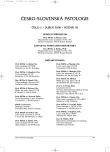-
Medical journals
- Career
Argyrophilic Grain Disease: Case Report of the First Two Cases in the Czech Republic and Review of the Literature
Authors: R. Matěj; F. Koukolík
Authors‘ workplace: Department of Pathology and Working Group for Diagnosis and Study of Neurodegenerative Disorders, Thomayer Teaching Hospital, Prague, Czech Republic
Published in: Čes.-slov. Patol., 42, 2006, No. 2, p. 66-70
Category:
Overview
Argyrophilic grain disease (AgD) is a relatively newly described neurodegenerative disease with late-onset dementia. Morphologically it is characterized by the presence of abundant spindleshaped argyrophilic grains (ArG) in neuronal processes and coiled bodies in oligodendrocytes. ArG consist of abnormally hyperphosphorylated form of tau protein. AgD is a substrate of at least 5% of all dementia cases with increasing incidence in the old age. Here we report the cases of a 91-yearold woman and an 83-year-old man clinically diagnosed with dementia. Neuropathological, histochemical and immunohistochemical examination of the brain tissue show the changes to be compatible with a definite diagnosis of AgD. This is the first description of two cases of AgD in the Czech Republic.
Key words:
argyrophilic grain disease – dementia – tau protein
Labels
Anatomical pathology Forensic medical examiner Toxicology
Article was published inCzecho-Slovak Pathology

2006 Issue 2-
All articles in this issue
- Dedifferentiated Mixed Stromal-Smooth Muscle Tumor of the Uterus. Report of a Case
- Epithelioid Hemangioma of the Foot
- Tumoriform Endometriosis of the Urinary Bladder in Advanced Pregnancy
- Inverse Correlation between HLA-DR Antigen Expression and CD4 Positive Lymphocytic Populations in Normal Mucosa, Tubulovillous Adenoma, and Invasive Carcinoma of the Colon
- Diagnostic Procedures in Skin Adnexal Tumours From histogenetic, morphologic and immunohistochemical point
- Argyrophilic Grain Disease: Case Report of the First Two Cases in the Czech Republic and Review of the Literature
- Mammary Carcinoma with Osteoclast-like Giant Cells – Report of Two Cases
- The Subacute Angiohypertrophic Myelomalacia Foix-Alajouanine – a Rare Disease?
- Czecho-Slovak Pathology
- Journal archive
- Current issue
- Online only
- About the journal
Most read in this issue- Argyrophilic Grain Disease: Case Report of the First Two Cases in the Czech Republic and Review of the Literature
- Tumoriform Endometriosis of the Urinary Bladder in Advanced Pregnancy
- Dedifferentiated Mixed Stromal-Smooth Muscle Tumor of the Uterus. Report of a Case
- Epithelioid Hemangioma of the Foot
Login#ADS_BOTTOM_SCRIPTS#Forgotten passwordEnter the email address that you registered with. We will send you instructions on how to set a new password.
- Career
